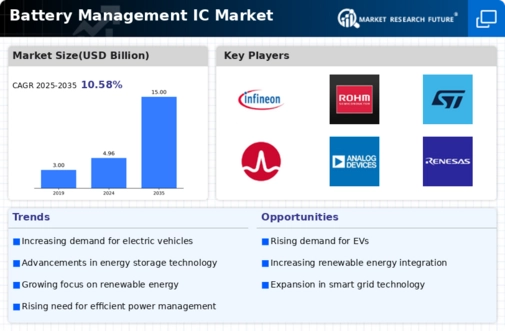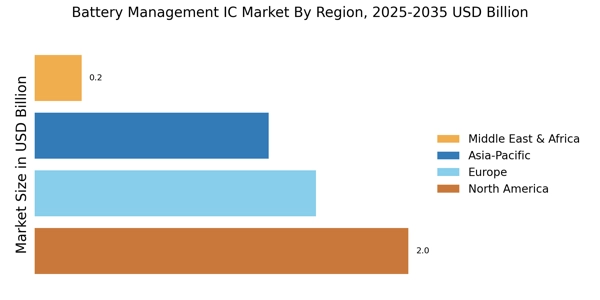Growth in Renewable Energy Storage
The expansion of renewable energy sources, such as solar and wind, is significantly influencing the Battery Management IC Market. As energy storage systems become essential for balancing supply and demand, the need for sophisticated battery management solutions intensifies. In 2025, the energy storage market is projected to reach a valuation of over 200 billion USD, with battery management ICs being integral to optimizing the performance of these systems. These ICs ensure efficient energy storage, enhance battery life, and improve safety protocols. The Battery Management IC Market is thus likely to experience robust growth, driven by the increasing integration of renewable energy technologies and the demand for efficient energy storage solutions.
Rising Consumer Electronics Market
The burgeoning consumer electronics market is a significant driver for the Battery Management IC Market. With the proliferation of portable devices such as smartphones, tablets, and wearables, the demand for efficient battery management solutions is on the rise. In 2025, the consumer electronics sector is projected to exceed 1 trillion USD, creating a substantial market for battery management ICs. These integrated circuits are essential for optimizing battery life, enhancing charging speeds, and ensuring device safety. As manufacturers strive to meet consumer expectations for longer-lasting and safer devices, the Battery Management IC Market is likely to benefit from this growing demand, leading to increased innovation and investment in battery management technologies.
Regulatory Push for Energy Efficiency
Regulatory frameworks aimed at enhancing energy efficiency are driving the Battery Management IC Market. Governments worldwide are implementing stringent regulations to promote energy conservation and reduce carbon emissions. These regulations often mandate the use of advanced battery management systems in various applications, including electric vehicles and renewable energy storage. In 2025, it is anticipated that compliance with these regulations will necessitate the adoption of sophisticated battery management ICs, which are crucial for monitoring and optimizing battery performance. This regulatory push not only fosters innovation within the Battery Management IC Market but also encourages manufacturers to develop more efficient and sustainable battery management solutions.
Increasing Adoption of Electric Vehicles
The rising adoption of electric vehicles (EVs) is a primary driver for the Battery Management IC Market. As consumers and manufacturers shift towards sustainable transportation solutions, the demand for efficient battery management systems escalates. In 2025, it is estimated that the EV market will witness a compound annual growth rate (CAGR) of approximately 20%, necessitating advanced battery management integrated circuits to optimize performance and safety. These ICs play a crucial role in monitoring battery health, ensuring longevity, and enhancing charging efficiency. Consequently, the Battery Management IC Market is poised for substantial growth, driven by the increasing number of EVs on the road and the need for reliable battery management solutions.
Technological Advancements in Battery Technologies
Technological advancements in battery technologies are propelling the Battery Management IC Market forward. Innovations such as solid-state batteries and lithium-sulfur batteries promise higher energy densities and improved safety features. As these technologies evolve, the demand for advanced battery management ICs that can handle complex battery chemistries and configurations increases. In 2025, the market for advanced battery technologies is expected to grow significantly, with battery management ICs playing a pivotal role in ensuring optimal performance and safety. This trend indicates a strong correlation between technological advancements in batteries and the growth of the Battery Management IC Market, as manufacturers seek to enhance battery efficiency and reliability.
















Leave a Comment